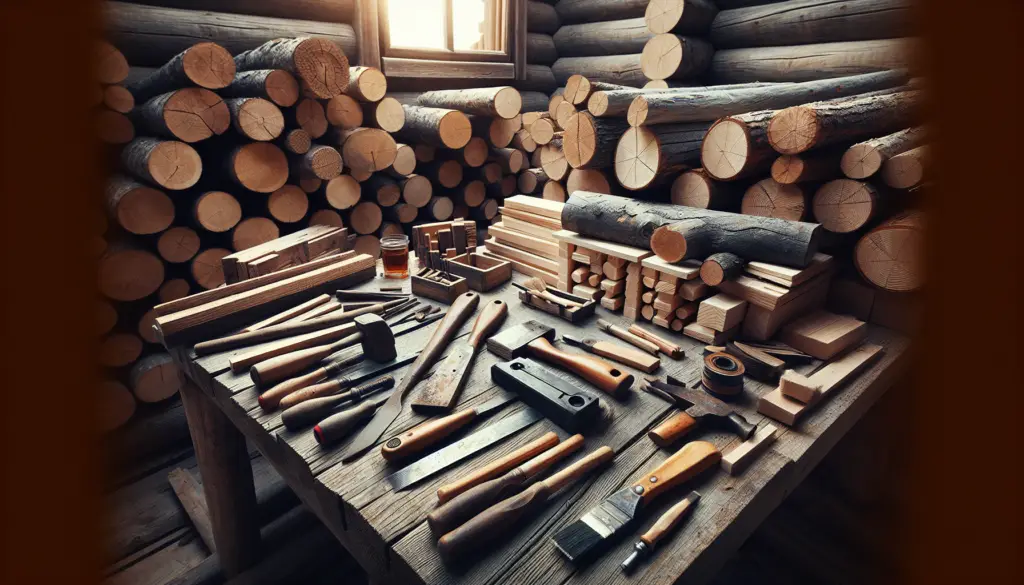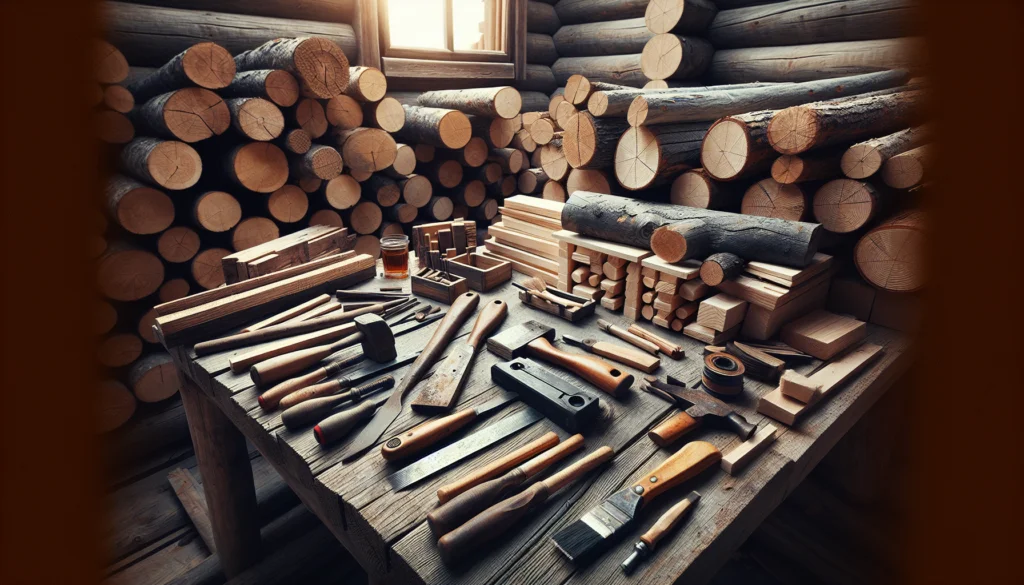Have you ever dreamed of building your own wood cabin in the middle of nature? Well, in this video by Quantum Tech HD, you’ll see Engin Bircan transform a plot of land into a beautiful wood cabin step by step. From ensuring the ground is leveled before starting the foundation, to recycling cans to create molds, Engin demonstrates his impressive skills in construction. He explains the importance of a sturdy foundation and how it distributes the weight of the cabin to the ground. With attention to detail and the use of reliable tools such as screws, nails, and brackets, Engin constructs the cabin’s structure and roof, ensuring everything is level and well-supported. The video also showcases the benefits of using wood as a building material, such as its natural insulation properties and resistance to earthquakes. So, if you’re curious to see this amazing DIY project come to life, check out Engin Bircan’s YouTube channel and be inspired to create your own wood masterpiece.
Preparing the Ground

This image is property of i.ytimg.com.
Leveling the site
Before starting the construction of your wood cabin, it is important to ensure that the site is properly leveled. This will provide a solid and stable base for the foundation of the cabin. Leveling the site involves removing any uneven or protruding surfaces and filling in any depressions or holes. It is recommended to use a spirit level or a laser level to accurately determine if the site is level.
Creating foundation molds
Once the site is leveled, the next step is to create foundation molds. These molds will serve as the formwork for pouring concrete or laying bricks to create the foundation of the wood cabin. The molds can be created using recycled materials such as old wooden planks or metal sheets. It is important to ensure that the molds are sturdy and properly aligned to ensure the foundation is built accurately.
Reducing material consumption
To reduce material consumption and make your wood cabin more sustainable, consider using recycled or reclaimed materials whenever possible. This not only helps reduce waste but also adds character and uniqueness to your cabin. Additionally, consider using materials that have a lower carbon footprint, such as sustainably sourced wood or eco-friendly composite materials. With proper planning and resourcefulness, you can create a beautiful wood cabin while minimizing environmental impact.
Building the Foundation
Distributing the loads
A critical aspect of building a strong and stable foundation for your wood cabin is distributing the loads evenly. This ensures that the weight of the cabin is properly supported by the foundation and prevents any uneven settling or structural issues. Proper load distribution can be achieved by using appropriate foundation designs, such as strip foundations or pad foundations, and ensuring that the foundation is properly reinforced.
Choosing the right materials
When building the foundation of your wood cabin, it is important to choose the right materials that can withstand the weight and environmental conditions. Concrete is commonly used for foundation construction due to its durability and strength. Another option is using bricks or stone, which can provide a more aesthetically pleasing foundation. Whichever material you choose, make sure it is compatible with the site conditions and ensure proper insulation and waterproofing to protect the foundation from moisture damage.
Building a stable foundation
To ensure the stability of the foundation, it is crucial to follow proper construction techniques. This includes accurately measuring and marking the foundation layout, ensuring that the foundation is level and plumb, and using appropriate reinforcement such as rebar or mesh. Adequate curing time should also be allowed for the foundation to fully dry and gain strength before proceeding with the construction of the wood cabin. Taking these steps will help ensure a solid and stable foundation that can support the weight of the cabin for years to come.
Starting the Construction
Building the structure from the top
Once the foundation is completed and properly cured, you can start the construction of the wood cabin structure. Starting from the top ensures that the weight of the structure is evenly distributed and prevents any settling or deformation of the foundation. Begin by constructing the roof trusses or framing, followed by the installation of walls and floors. It is important to ensure that each component is properly aligned and securely fastened to maintain the structural integrity of the cabin.
Ensuring even parts
To achieve a professionally built wood cabin, it is essential to ensure that all parts are even and properly fitted together. This involves accurate measurements, precise cutting, and careful assembly. Using proper tools such as tape measures, levels, and square rulers can help ensure the accuracy of the parts. Taking the time to double-check measurements and make necessary adjustments will result in a more aesthetically pleasing and structurally sound wood cabin.
Addressing uneven surfaces
During the construction process, it is common to encounter uneven surfaces or gaps between parts. These uneven surfaces can affect the stability and appearance of the wood cabin. It is important to address these issues by using shims, sanding, or adjusting the components as needed. Properly addressing uneven surfaces ensures a smooth and seamless finish, enhancing the overall quality of the wood cabin.
Using the Right Tools
Recognized woodworker tools
To build a wood cabin effectively, it is essential to have the right tools. Recognized woodworker tools, such as saws, chisels, planes, and drills, are necessary for cutting, shaping, and joining wood components. Each tool serves a specific purpose and using the right tool for each task ensures accurate and efficient construction.
Commonly used screws and nails
Screws and nails are essential fasteners used in wood cabin construction. Common types include traditional screws, lag screws, wood screws, nails, and split rings. These fasteners provide secure and reliable connections between wood components. Choosing the right type and size of screws or nails based on the application is crucial to ensure the strength and longevity of the wood cabin.
Essential workshop equipment
Having essential workshop equipment is essential for a smooth construction process. This includes tools such as table saws, band saws, and radial arm saws for cutting wood accurately. Additionally, equipment such as planers, lathes, and drill presses can be used for shaping and finishing wood components. Having a well-equipped workshop ensures that you have the necessary tools and equipment to effectively build your wood cabin.
Assembly and Joinery Techniques

Classification of hand tools
Hand tools are classified into various categories based on their functions. These categories include wrenches, pliers, cutters, striking tools, hammers, screwdrivers, sockets, clamps, shears, saws, drills, and knives. Each category consists of specific tools designed for specific tasks. Understanding the different types of hand tools and their uses is important for efficiently and effectively assembling and joining wood cabin components.
Importance of meticulously crafted joints
Meticulously crafted joints are crucial for the structural integrity and longevity of a wood cabin. Different types of joints, such as butt joints, lap joints, mortise and tenon joints, and dovetail joints, have different levels of strength and aesthetics. Choosing the appropriate joint for each connection and ensuring precise and accurate craftsmanship in creating the joint will result in a strong and visually appealing wood cabin.
The art of using wood glue
Wood glue is an essential adhesive used in wood cabin construction. It provides a strong bond between wood components and enhances the overall strength and stability of the cabin. When using wood glue, it is important to apply an even and sufficient amount to the surfaces to be bonded. Join the glued surfaces tightly and clamp them together until the glue dries completely. Following proper wood glue application techniques ensures solid and long-lasting joints in the wood cabin.
Installing Flooring and Roofing
Using OSB for a flat structure
OSB (Oriented Strand Board) is commonly used in wood cabin construction for creating a flat and stable structure. It is manufactured using waterproof adhesive and heat-treated rectangular wood strands. OSB is widely used for sheathing walls, subflooring, roof decking, and I-joists. It has similar strength and performance to plywood, with resistance to sagging, warping, and deformation.
Benefits and uses of OSB
OSB offers various benefits and uses in wood cabin construction. It is cost-effective, readily available, and easy to work with. OSB provides structural stability, thermal insulation, and soundproofing properties to the cabin. It can also be used as a decorative element, as it can be stained or painted to enhance the cabin’s aesthetic appeal. Additionally, OSB is a sustainable choice, as it can be produced from fast-growing and renewable wood sources.
Metal roofing and its advantages
Metal roofing is a popular choice for wood cabin construction due to its durability and longevity. Metal roofs are resistant to weathering, corrosion, and fire, making them a safe and low-maintenance option. They offer excellent thermal insulation, reducing energy consumption for heating and cooling. Metal roofs are also lightweight, easy to install, and provide a sleek and modern aesthetic to the wood cabin. With proper installation and maintenance, a metal roof can last for several decades.
Window Framing

Handling window weight
Windows can vary in weight depending on their size and materials used. When framing windows in a wood cabin, it is important to consider the weight of the windows and ensure that the window frames are designed to bear the load. Proper support and reinforcement should be incorporated into the window framing to prevent sagging or structural issues. This can be achieved through the use of appropriate frame materials, such as robust wooden frames or engineered structural components.
Wooden frame benefits
Wooden window frames offer various benefits in wood cabin construction. Wood is a natural insulator, providing excellent thermal performance and reducing energy costs. Wooden frames offer better resistance to outdoor elements and noise compared to other frame options. Additionally, wooden frames have a timeless and aesthetic appeal, adding warmth and charm to the wood cabin’s interior and exterior. With proper maintenance, wooden window frames can last for many years.
Longevity and effectiveness of wooden frames
Wooden window frames are known for their longevity and effectiveness. With proper maintenance and periodic painting or sealing, wooden frames can withstand the test of time and harsh weather conditions. However, it is important to address any signs of decay, rot, or damage in the frames promptly to avoid compromising their structural integrity. Regular inspections and maintenance are key to ensuring the longevity and effectiveness of wooden frames in a wood cabin.
Engin Bircan’s Woodworking Projects
Engin’s outdoor workshop
Engin Bircan, a skilled woodworker and creator, has an outdoor workshop where he builds various woodworking projects, including wood cabins. His outdoor workshop provides a convenient and spacious environment for him to construct anything he desires. Engin’s workshop is equipped with essential tools and equipment, allowing him to bring his woodworking projects to life.
Incredible wooden projects
Engin Bircan’s woodworking projects are truly incredible. He showcases his craftsmanship and creativity through the construction of wood cabins, furniture, and decorative items. Engin’s attention to detail and passion for woodworking are evident in the quality and uniqueness of his projects. His work serves as inspiration for aspiring woodworkers and individuals interested in building their own wood cabin.
Inspiration for building your own cabin
Engin Bircan’s woodworking projects can serve as inspiration for building your own wood cabin. By observing and learning from his techniques and designs, you can gain valuable insights and ideas for your own project. Engin’s passion and dedication to woodworking demonstrate that with the right skills, tools, and materials, anyone can build their dream wood cabin. Get motivated and start planning your own wood cabin adventure.
Timber Framing Techniques
Ancient building method
Timber framing is an ancient building method that dates back hundreds, if not thousands, of years. It involves constructing structures using large timber beams and joints that interlock without the need for metal fasteners. Timber framing provides strength and durability, allowing for the construction of large and open spaces. This traditional building method has stood the test of time and continues to be utilized in modern wood cabin construction.
Environmental benefits of using wood
Wood is considered an environmentally friendly building material. It is a renewable resource that requires less carbon emissions to produce compared to steel or concrete. Additionally, wood sequesters carbon, providing a natural means of reducing greenhouse gases when trees die and decompose. Using wood in construction reduces the reliance on non-renewable resources and contributes to sustainable building practices.
Cost-effectiveness of timber framing
Building a wood cabin with timber framing can offer cost savings compared to other building methods. While the initial savings may not seem significant, the larger the construction site, the more substantial the savings can be. Timber framing requires less labor and materials, as it utilizes large beams and interlocking joints instead of intricate and time-consuming techniques. When considering the long-term costs, timber framing proves to be a cost-effective choice for a wood cabin.
Preserving Wood
Egyptians as pioneers in wood preservation
The ancient Egyptians were pioneers in wood preservation techniques. They developed methods to protect wooden artifacts and structures from decay, such as the use of oils, resins, and varnishes. By applying sealants and coatings to wooden objects, the Egyptians were able to maintain their integrity and extend their lifespan. Their knowledge and practices laid the foundation for modern wood preservation methods.
Application of sealants to maintain wooden objects
Sealants play a vital role in maintaining wooden objects, including wood cabins. Applying sealants to the surface of the wood creates a protective barrier that prevents moisture penetration, rot, and decay. Sealants also enhance the natural beauty of the wood and can provide additional benefits such as UV protection and resistance to insects and mold. Regular maintenance and reapplication of sealants are necessary to ensure the longevity and beauty of the wood cabin.
The world’s most expensive chair
The world’s most expensive chair, called the Dragons Chair, was designed by Eileen Gray. This piece of furniture exemplifies the craftsmanship and value placed on high-quality woodwork. The chair sold for approximately 28 million dollars. It serves as a testament to the artistic and functional possibilities of woodworking and reminds us of the value that can be attributed to well-crafted wooden objects.
Building an amazing DIY wood cabin step by step requires a significant amount of skill and materials. If you’re skeptical, just take a look at this impressive job done by the creator. Check out this review of cabin construction by the talented Engin Bircan and share your thoughts. Enjoy!
For more inspiration, you can follow Engin Bircan’s work on:
- Instagram: /engin1can
- Youtube: /woodworkerenginbircan
- Facebook: /engin1can
Disclaimer: Quantum Tech HD is not associated with any of the businesses featured in this review. All trademarks belong to their respective owners.

